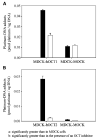Organic cation transporters are determinants of oxaliplatin cytotoxicity
- PMID: 16951202
- PMCID: PMC2775093
- DOI: 10.1158/0008-5472.CAN-06-0769
Organic cation transporters are determinants of oxaliplatin cytotoxicity
Abstract
Although the platinum-based anticancer drugs cisplatin, carboplatin, and oxaliplatin have similar DNA-binding properties, only oxaliplatin is active against colorectal tumors. The mechanisms for this tumor specificity of platinum-based compounds are poorly understood but could be related to differences in uptake. This study shows that the human organic cation transporters (OCT) 1 and 2 (SLC22A1 and SLC22A2) markedly increase oxaliplatin, but not cisplatin or carboplatin, accumulation and cytotoxicity in transfected cells, indicating that oxaliplatin is an excellent substrate of these transporters. The cytotoxicity of oxaliplatin was greater than that of cisplatin in six colon cancer cell lines [mean +/- SE of IC(50) in the six cell lines, 3.9 +/- 1.4 micromol/L (oxaliplatin) versus 11 +/- 2.0 micromol/L (cisplatin)] but was reduced by an OCT inhibitor, cimetidine, to a level similar to, or even lower than that of, cisplatin (29 +/- 11 micromol/L for oxaliplatin versus 19 +/- 4.3 micromol/L for cisplatin). Structure-activity studies indicated that organic functionalities on nonleaving groups coordinated to platinum are critical for selective uptake by OCTs. These results indicate that OCT1 and OCT2 are major determinants of the anticancer activity of oxaliplatin and may contribute to its antitumor specificity. They also strongly suggest that expression of OCTs in tumors should be investigated as markers for selecting specific platinum-based therapies in individual patients. The development of new anticancer drugs, specifically targeted to OCTs, represents a novel strategy for targeted drug therapy. The results of the present structure-activity studies indicate specific tactics for realizing this goal.
Figures






Similar articles
-
Factors affecting sensitivity to antitumor platinum derivatives of human colorectal tumor cell lines.Cancer Chemother Pharmacol. 2008 Sep;62(4):577-84. doi: 10.1007/s00280-007-0640-3. Epub 2007 Nov 21. Cancer Chemother Pharmacol. 2008. PMID: 18030470
-
Differential transport of platinum compounds by the human organic cation transporter hOCT2 (hSLC22A2).Br J Pharmacol. 2010 Feb;159(4):898-908. doi: 10.1111/j.1476-5381.2009.00569.x. Epub 2010 Jan 8. Br J Pharmacol. 2010. PMID: 20067471 Free PMC article.
-
Nephrotoxicity of platinum complexes is related to basolateral organic cation transport.Kidney Int. 2004 Jul;66(1):196-202. doi: 10.1111/j.1523-1755.2004.00720.x. Kidney Int. 2004. PMID: 15200426
-
[Platinum agent-induced nephrotoxicity via organic cation transport system].Yakugaku Zasshi. 2012;132(11):1281-5. doi: 10.1248/yakushi.12-00211. Yakugaku Zasshi. 2012. PMID: 23123720 Review. Japanese.
-
Drug transporters of platinum-based anticancer agents and their clinical significance.Drug Resist Updat. 2011 Feb;14(1):22-34. doi: 10.1016/j.drup.2010.12.002. Epub 2011 Jan 20. Drug Resist Updat. 2011. PMID: 21251871 Review.
Cited by
-
Metallo-Drugs in Cancer Therapy: Past, Present and Future.Molecules. 2022 Oct 1;27(19):6485. doi: 10.3390/molecules27196485. Molecules. 2022. PMID: 36235023 Free PMC article. Review.
-
CircRNAs in anticancer drug resistance: recent advances and future potential.Mol Cancer. 2020 Aug 17;19(1):127. doi: 10.1186/s12943-020-01240-3. Mol Cancer. 2020. PMID: 32799866 Free PMC article. Review.
-
Protective Effect of Natural Antioxidants on Reducing Cisplatin-Induced Nephrotoxicity.Dis Markers. 2022 Nov 14;2022:1612348. doi: 10.1155/2022/1612348. eCollection 2022. Dis Markers. 2022. PMID: 36419843 Free PMC article. Review.
-
Renal hypoxia-HIF-PHD-EPO signaling in transition metal nephrotoxicity: friend or foe?Arch Toxicol. 2022 Jun;96(6):1573-1607. doi: 10.1007/s00204-022-03285-3. Epub 2022 Apr 21. Arch Toxicol. 2022. PMID: 35445830 Free PMC article. Review.
-
In-vitro study of Ketoprofen Release from Synthesized Silica Aerogels (as Drug Carriers) and Evaluation of Mathematical Kinetic Release Models.Iran J Pharm Res. 2018 Summer;17(3):818-829. Iran J Pharm Res. 2018. PMID: 30127808 Free PMC article.
References
-
- Wong E, Giandomenico CM. Current status of platinum-based antitumor drugs. Chem Rev. 1999;99:2451–66. - PubMed
-
- Weiss RB, Christian MC. New cisplatin analogues in development. A review. Drugs. 1993;46:360–77. - PubMed
-
- Rixe O, Ortuzar W, Alvarez M, et al. Oxaliplatin, tetraplatin, cisplatin, and carboplatin: spectrum of activity in drug-resistant cell lines and in the cell lines of the National Cancer Institute's Anticancer Drug Screen panel. Biochem Pharmacol. 1996;52:1855–65. - PubMed
-
- Raymond E, Chaney SG, Taamma A, Cvitkovic E. Oxaliplatin: a review of preclinical and clinical studies. Ann Oncol. 1998;10:1053–71. - PubMed
-
- Misset JL, Bleiberg H, Sutherland W, Bekradda M, Cvitkovic E. Oxaliplatin clinical activity: a review. Crit Rev Oncol Hematol. 2000;35:75–93. - PubMed
Publication types
MeSH terms
Substances
Grants and funding
LinkOut - more resources
Full Text Sources
Other Literature Sources
Molecular Biology Databases

